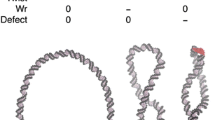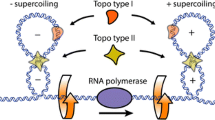Abstract
In DNA transcription, the base pairs are unzipped in response to the enzymatic forces, separating apart two intertwined nucleotide strands. Consequently, the double-stranded DNA (dsDNA), in which two nucleotide strands wind about each other, transits structurally to the single-stranded DNA (ssDNA) in which two nucleotide strands are completely unwound and separated. The large interstrand separation is intimately related to the softening nucleotide strands. This conceptual framework is reinforced with the flow of the bending modulus toward zero under recursion relations derived from the momentum shell renormalization group. Interestingly, the stretch modulus remains the same under recursion relations. The renormalization of the bending modulus to zero has a profound implication that ssDNA has the shorter bending persistence length than does dsDNA in accordance with experiments.





Similar content being viewed by others
References
Bockelmann, U., Thomen, P., Heslot, F.: Dynamics of the DNA duplex formation studied by single molecule force measurements. Biophys. J. 87, 3388–3396 (2004)
Palmeri, J., Manghi, M., Destainville, N.: Thermal denaturation of fluctuating finite DNA chains: the role of bending rigidity in bubble nucleation. Phys. Rev. E 77, 11913–11939 (2008)
Mills, J.B., Hagerman, P.J.: Origin of the intrinsic rigidity of DNA. Nucleic Acids Res. 32, 4055–4059 (2004)
Vologodskii, A.V., Marko, J.F.: Extension of torsionally stressed DNA by external force. Biophys. J. 73, 123–132 (1997)
Cherstvy, A.G.: Torque-induced deformations of charged elastic DNA rods: thin helices, loops, and precursors of DNA supercoiling. J. Biol. Phys. 37, 227–238 (2011)
Gore, J., Bryant, Z., Nöllmann, M., Le, M.U., Cozzarelli, N.R., Bustamante, C.: DNA overwinds when stretched. Nature 442, 836–839 (2006)
Doi, M., Edwards, S.F.: The Theory of Polymer Dynamics. Oxford University Press, Oxford (2001)
Marko, J.F., Siggia, E.D.: Stretching DNA. Macromolecules 28, 8759–8770 (1995)
Jeon, J., Sung, W.: An effective mesoscopic model of double-stranded DNA. J. Biol. Phys. 40, 1–14 (2014)
Lee, O., Jeon, J., Sung, W.: How dsDNA breathing enhances its flexibility and instability on short-length scales. Phys. Rev. E 81, 021906 (2010)
Alberts, B., Bray, D., Lewis, J., Ruff, M., Roberts, K., Watson, J.D.: Molecular Biology of the Cell. Garland Publishing, New York (1994)
Lubensky, D.K., Nelson, D.R.: Pulling pinned polymers and unzipping DNA. Phys. Rev. Lett. 85, 1572–1575 (2000)
Chaikin, P.M., Lubensky, T.C.: Principles of Condensed Matter Physics. Cambridge University Press, New York (2000)
The detailed calculation of the partition function Z and of the root-mean-square separation r r m s (s) are presented in the online supplementary material.
Smith, S.B., Cui, Y., Bustamante, C.: Overstretching B-DNA: the elastic response of individual double-stranded and single-stranded DNA molecules. Science 271, 795–799 (1996)
Kim, J., Jeon, J., Sung, W.: A breathing wormlike chain model on DNA denaturation and bubble: effects of stacking interactions. J. Chem. Phys. 128, 055101 (2008)
Landau, L.D., Lifshitz, E.M.: Theory of Elasticity. Pergamon, Oxford (1986)
Austin, R.H., Brody, J.P., Cox, E.C., Duke, T., Volkmuth, W.: Stretch genes. Phys. Today 50, 32–38 (1997)
Gelbart, W.M., Bruinsma, R.F., Pincus, P.A., Parsegian, V.A.: DNA-inspired electrostatics. Phys. Today 53, 38–44 (2000)
Podgornik, R., Hansen, P.L., Parsegian, V.A.: Elastic moduli renormalization in self-interacting stretchable polyelectrolytes. J. Chem. Phys. 113, 9343–9350 (2000)
Shin, J., Cherstvy, A.G., Metzler, R.: Sensing viruses by mechanical tension of DNA in responsive hydrogels. Phys. Rev. X 4, 021002 (2014)
Acknowledgments
The author is indebted to N. Chaichit for his insightful discussions and to Thammasat University for the TU new research scholar, contract number 2557. He also gratefully acknowledges the anonymous reviewers for their constructive comments and invaluable suggestions.
Author information
Authors and Affiliations
Corresponding author
Electronic supplementary material
Below is the link to the electronic supplementary material.
Appendix: Derivation of recursion relations by momentum shell renormalization group
Appendix: Derivation of recursion relations by momentum shell renormalization group
We present the detail of calculation leading to the recursion relations, (17), governing how the stretch modulus A, bending modulus B, helix wavevector k 0, and the force components F x ,F y change as approaching to the dsDNA-to-ssDNA transition. The elastic properties, like stretch modulus A and bending modulus B, are insensitive to the short distance structure, i.e., large wavevector q. The dsDNA-to-ssDNA transition can be equally described by the Hamiltonian, which involves only the small wavevector q but with the parameters in the Hamiltonian being renormalized. The large wavevector corresponds to the high momentum. Integrating out the high momentum part of the field r >(q) appearing in the Hamiltonian H >, (15), leads to the new Hamiltonian H Λ/b [r <(q)], involving only the low momentum part of the field r <(q) with small wavevector 0<q<Λ/b
The new Hamiltonian therefore takes the form
where the constant is
Note that the second term in D is −k B T lnC, recalling the constant C from (9). To restore the momentum cutoff Λ/b back to Λ, the momentum is rescaled by q=q ′/b and the field is rescaled by r <(q)=ζ r ′(q ′), corresponding to, in real space, the arc length rescaled by s=b s ′ and the field rescaled by r <(s)=(1/ζ)r ′(s ′). This momentum and field rescaling results in a new Hamiltonian \(H_{\Lambda }^{\prime }[\textbf {r}^{\prime }(q^{\prime })]\), but now with the same momentum cutoff Λ as does the original Hamiltonian H,
This new Hamiltonian \(H_{\Lambda }^{\prime }[\textbf {r}^{\prime }(q^{\prime })]\), (24), has the identical form of the original Hamiltonian H[r(q)], (6), suggesting that the stretch modulus A, bending modulus B, helix wavevector k 0, and the force components F x ,F y must be renormalized according to
The rescaling parameter ζ for the field is chosen to satisfy the scaling law of correlation. The inverse of the correlation \(G_{ii}^{-1}(s, s^{\prime })\) is the second functional derivative evaluated at the mean-field solution <r i (s)> [13]
Using the relative-coordinate part of Hamiltonian (5) gives
With the Fourier transform of the delta function, \(\delta (s - s^{\prime }) = \int (dq/2\pi ) \exp (iq(s - s^{\prime }) )\), substitute (27) in (26) gives the inverse of the correlation
which is the Fourier transform of \(G_{ii}^{-1}(s, s^{\prime })\). Apart from exp(i q(s−s ′)), the integrand is the inverse of the correlation in momentum space \(G_{ii}^{-1}(q)\), resulting in the correlation
Rescale the momentum q=q ′/b changes the correlation to
whose the scaling law is \(G_{ii}(q) = b^{2}G_{ii}^{\prime }(q^{\prime })\), where the correlation \(G_{ii}^{\prime }(q^{\prime })\) has the identical form with G i i (q) but with the renormalized stretch modulus A ′, the renormalized bending modulus B ′, and the renormalized helix wavevector \(k_{0}^{\prime }\)
To fulfill the scaling law of correlation, we choose the rescaling parameter ζ 2=2b 3, which simplifies (25) to
which are indeed the recursion relations (17) in the main text.
Rights and permissions
About this article
Cite this article
Amnuanpol, S. Physical origin of DNA unzipping. J Biol Phys 42, 69–82 (2016). https://doi.org/10.1007/s10867-015-9393-0
Received:
Accepted:
Published:
Issue Date:
DOI: https://doi.org/10.1007/s10867-015-9393-0




